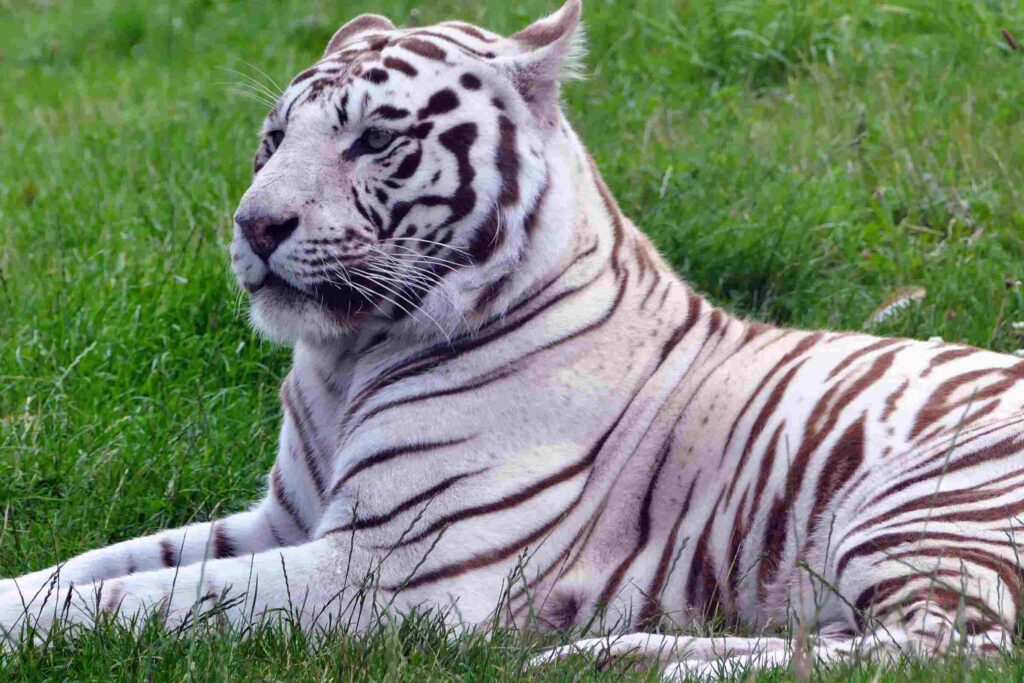
Tiger: The Apex Predator of Asia
The tiger (Panthera tigris), one of the most iconic and majestic creatures on Earth, stands as a symbol of strength, power, and grace.
As the largest member of the cat family (Felidae), the tiger’s striking appearance and formidable hunting prowess have made it a centerpiece of fascination in cultures worldwide.
Despite its fearsome reputation, the tiger is also an endangered species, with its population facing severe threats from habitat destruction, poaching, and human-wildlife conflict.
This article uncover the biology, behavior, habitats, and conservation efforts surrounding the tiger, while also exploring its significance in human culture.
Etymology and Taxonomy
The word “tiger” has a rich history, with its origins tracing back to Old English, derived from the Old French word tigre, which itself comes from the Latin tigris.
The Latin term was borrowed from the Classical Greek τίγρις (tigris), which referred to the tiger and possibly the Tigris River.
It is believed that the name might have originated from the Armenian or Persian word for “arrow,” symbolizing the tiger’s swift movements.
However, the connection between the tiger and the river Tigris is now largely considered a case of homonymy, with no real etymological link between the two.
Tigers belong to the genus Panthera, which also includes lions, leopards, jaguars, and snow leopards.
The scientific classification of the tiger has undergone several changes since it was first described by Carl Linnaeus in 1758 as Felis tigris.
Later, in 1929, Reginald Innes Pocock reclassified the tiger under the genus Panthera, leading to the current binomial name Panthera tigris.
Subspecies and Evolution
Historically, nine tiger subspecies were recognized: the Bengal, Malayan, Indochinese, South China, Siberian, Caspian, Javan, Bali, and Sumatran tigers.
However, modern genetic research has questioned the validity of some of these subspecies, leading to debates over their classification.
Recent whole-genome sequencing studies have found that some of the formerly distinct subspecies, such as the Bengal, Siberian, and Sumatran tigers, have unique genetic traits, supporting the idea that these populations are evolutionarily distinct.
However, with tiger populations severely fragmented and declining, the future of their genetic diversity remains uncertain.
The evolutionary history of the tiger traces back to the early Pleistocene epoch, with fossil records indicating the presence of ancestral tiger species in northern China.
The modern tiger’s closest relative is the snow leopard, with whom it shares a common ancestor that lived between 2.7 and 3.7 million years ago.
Physical Characteristics
Tigers are known for their distinctive orange coats with black vertical stripes, though the exact pattern and coloration vary depending on the subspecies and individual.
The tiger’s coat serves as camouflage, blending perfectly with its forested and grassland habitats. Interestingly, the stripes on each tiger are unique, much like human fingerprints, allowing researchers to identify individuals based on their markings.
Size and Weight
Tigers are the largest of the big cats, with male Bengal and Siberian tigers reaching lengths of up to 3.3 meters (11 feet) and weighing between 200 to 300 kilograms (440 to 660 pounds).
Females are generally smaller, weighing between 100 to 160 kilograms (220 to 350 pounds).
The Sumatran tiger, the smallest subspecies, weighs between 75 and 140 kilograms (165 to 310 pounds), likely due to insular dwarfism—a phenomenon where animals on islands tend to evolve smaller body sizes.
Coat and Coloration
The tiger’s coat is typically a vibrant orange or reddish color, with white fur on the belly, chest, and parts of the face.
The dark stripes vary in thickness and pattern, often becoming denser towards the back and flanks. In some cases, the stripes may split or fuse, adding to the tiger’s unique appearance.
Tigers from colder climates, such as the Siberian tiger, tend to have thicker, longer coats to protect them from harsh winters.

Their fur can grow up to 105 millimeters (4.1 inches) in length in colder months.
Tigers also have a range of color variations. The white tiger, for instance, is a rare morph with pale fur and sepia-brown stripes.
This variation is caused by a recessive gene and is most commonly seen in Bengal tigers.
Another rare variant is the golden tiger, which has a pale golden coat with reddish-brown stripes, also due to genetic mutations.
While these color morphs are often bred in captivity, they are extremely rare in the wild.
Anatomy
The tiger’s muscular body is built for strength and agility. It has a large head, powerful jaws, and long canines, which can grow up to 7.6 centimeters (3 inches) in length, making them the longest among all felids.
The tiger’s retractable claws, which can reach up to 10 centimeters (3.9 inches), are essential tools for gripping prey and climbing.
Tigers are also known for their exceptional swimming ability, and they often cross rivers and lakes in search of prey or new territories.
Habitat and Distribution
Historically, tigers ranged across much of Asia, from eastern Turkey and the Caucasus through Central and South Asia, and from the Russian Far East to Indonesia.
However, today, their range has been dramatically reduced, and tigers are now found in scattered, fragmented populations across South and Southeast Asia, the Russian Far East, and parts of China.
The largest remaining populations are in India, which is home to more than half of the world’s tiger population.
Preferred Habitats
Tigers are highly adaptable animals and can thrive in a variety of habitats, from tropical rainforests and mangroves to grasslands and temperate forests.
They are primarily forest dwellers, and forests provide them with the cover and prey they need to survive.
In the Russian Far East, tigers inhabit coniferous and temperate broadleaf forests, while in Southeast Asia and the Indian subcontinent, they prefer tropical and subtropical moist broadleaf forests.
In India, tigers are found in a wide range of habitats, including the Sundarbans mangrove forests, tropical dry forests, and the Himalayan foothills.
Tigers have also been recorded at high altitudes in Bhutan and the Tibetan Plateau, with some individuals found at elevations of up to 4,200 meters (13,800 feet).
Current Range and Population
As of 2022, tigers occupy less than 7% of their historical range, and their populations are severely fragmented.
India has the largest extent of tiger habitat, with over 300,000 square kilometers (116,000 square miles) of suitable terrain.
Russia follows with nearly 200,000 square kilometers (75,000 square miles) of tiger habitat.
However, in many areas, the tiger’s range is shrinking due to deforestation, habitat destruction, and human encroachment.
The global tiger population is estimated to be fewer than 4,000 individuals, with around 2,500 of these in India.
Other significant populations are found in Russia, Nepal, Bhutan, and Indonesia, though many of these populations are isolated and face ongoing threats.
Tigers are considered endangered by the International Union for Conservation of Nature (IUCN), and their numbers continue to decline, particularly in Southeast Asia, where poaching and habitat loss are rampant.
Behavior and Ecology
Tigers are solitary and territorial animals, with males and females establishing home ranges that they defend from others of the same sex.
Male home ranges are generally larger than those of females and often overlap with the territories of several females.
The size of a tiger’s home range depends on the availability of prey, habitat quality, and the presence of competitors.
Social Structure and Territoriality
Tigers are not social animals like lions, and they lead largely solitary lives.
They do, however, establish territories, especially males, who mark their ranges with scent markings, urine, and scratch marks on trees.
These marks serve as a warning to other tigers, signaling that the area is already claimed.
A male tiger’s home range can overlap with the territories of several females, and he will mate with any receptive females within his range.
Females, on the other hand, maintain smaller territories, which they fiercely defend from other females.
The size of a female’s territory is largely determined by the availability of prey, as she needs to provide for her cubs.
When her cubs reach independence, usually at around two years of age, they leave her territory and establish their own.
Hunting and Diet of Tigers
Tigers are apex predators, meaning they sit at the top of the food chain and have no natural predators.
They primarily hunt large ungulates such as deer, wild boar, and antelope, though their diet can vary depending on prey availability.
In Russia, for example, Siberian tigers often prey on elk and wild boar, while in India, Bengal tigers hunt chital, sambar deer, and gaur.

Tigers are ambush predators, relying on stealth and surprise to take down their prey. They typically stalk their quarry, getting as close as possible before launching a quick, powerful attack.
A tiger’s bite force is incredibly strong, and they usually kill their prey by biting the throat or the back of the neck, severing the spinal cord or crushing the windpipe.
After making a kill, a tiger will drag its prey to a secluded spot to feed, often covering it with leaves or dirt to hide it from scavengers.
Communication
Tigers communicate with each other through vocalizations, scent markings, and body language.
They produce a range of sounds, including roars, growls, moans, and chuffing—a softer, friendly sound made during close social encounters.
A tiger’s roar can be heard over long distances, and it serves as a way to communicate with potential mates or deter rivals. Scent marking is another important form of communication.
Tigers spray urine on trees, rocks, or bushes to mark their territory, and they also use glandular secretions from their cheeks and paws to leave their scent.
These markings provide information about the tiger’s identity, reproductive status, and territory boundaries.
Reproduction and Life Cycle
Tigers breed year-round, though most mating occurs between November and April.
After a gestation period of about 103 days, the female gives birth to a litter of two to four cubs. She raises the cubs on her own, as male tigers do not participate in parental care.
The cubs are born blind and helpless, relying entirely on their mother for food and protection.
The mother nurses her cubs for the first six months, after which they begin to eat meat. However, they do not start hunting until they are about 18 months old.
Cubs usually stay with their mother for two years, learning essential hunting and survival skills, before leaving to establish their own territories.
Threats to Tiger Survival
Despite the tiger’s fearsome reputation, it faces numerous threats in the wild, most of which are caused by human activities.
The tiger’s population has plummeted by more than 93% since the early 20th century, and today, tigers are extinct in many parts of their former range, including Western and Central Asia, Java, and Bali.
Habitat Destruction and Fragmentation
One of the primary threats to tigers is habitat destruction.
As human populations expand, forests are cleared for agriculture, logging, and infrastructure projects, leaving tigers with smaller and more fragmented territories.
Without sufficient habitat, tigers struggle to find prey, maintain their territories, and reproduce.
Fragmentation of tiger habitat also leads to increased human-wildlife conflict.
As tigers move through fragmented landscapes, they often come into contact with human settlements, where they may prey on livestock or, in rare cases, attack humans.
These conflicts frequently result in the tiger being killed in retaliation.
Poaching and Illegal Wildlife Trade
Tigers are also targeted by poachers for their skins, bones, and other body parts, which are highly valued in traditional medicine, particularly in parts of Asia.
Despite international bans on the trade of tiger parts, the illegal wildlife trade continues to thrive, driven by high demand and weak law enforcement in some regions.
Poaching has decimated tiger populations across their range.
In Southeast Asia, for example, poaching has been a major factor in the decline of tigers, and in some countries, such as Cambodia and Laos, tigers are now functionally extinct.
Human-Wildlife Conflict
As tiger habitats shrink, the likelihood of conflict between tigers and humans increases. In areas where natural prey is scarce, tigers may turn to livestock as an easy food source, leading to retaliatory killings by farmers.
In the Sundarbans, a unique habitat where tigers and humans coexist in close proximity, tiger attacks on humans are relatively frequent, though conservation efforts have been made to mitigate these conflicts.
Inbreeding and Genetic Isolation
With tiger populations becoming increasingly fragmented, genetic diversity is another concern.
Small, isolated populations are more vulnerable to inbreeding, which can lead to reduced fertility, increased susceptibility to disease, and other genetic problems.
Conservationists are working to address this issue by establishing wildlife corridors that connect isolated populations, allowing for greater gene flow and reducing the risk of inbreeding.
Tigers: Conservation Efforts
Recognizing the dire situation facing tigers, conservationists have launched a variety of initiatives aimed at protecting these magnificent animals and their habitats.
Many countries, particularly India, Russia, and Nepal, have made significant strides in tiger conservation, but challenges remain.
Protected Areas and Wildlife Corridors
One of the most effective strategies for tiger conservation has been the establishment of protected areas, such as national parks and wildlife reserves, where tigers can live and breed without the threat of poaching or habitat destruction.
In India, for example, Project Tiger was launched in 1973 to create protected areas for tigers, and it has been credited with helping to stabilize the country’s tiger population.
Wildlife corridors are another essential tool for tiger conservation. These corridors connect fragmented habitats, allowing tigers to move between different areas in search of mates and prey.
By enabling tigers to disperse and interbreed, wildlife corridors help maintain genetic diversity and reduce the risk of inbreeding.
Tigers: Anti-Poaching Measures
Anti-poaching efforts are crucial to the survival of wild tigers. Many countries have increased patrols in protected areas, trained special anti-poaching units, and implemented stricter penalties for those caught poaching or trafficking tiger parts.
In some regions, technology such as camera traps and drones is being used to monitor tiger populations and detect poachers.
Community Engagement and Livelihood Programs
Involving local communities in tiger conservation is essential for long-term success. Many conservation programs now focus on providing alternative livelihoods for people living near tiger habitats, reducing their reliance on activities such as logging or poaching.
In the Sundarbans, for example, honey collection and eco-tourism have been promoted as sustainable alternatives to tiger poaching.
Education and awareness campaigns are also important tools for changing attitudes toward tigers.
By highlighting the ecological importance of tigers and their role in maintaining healthy ecosystems, conservationists have been able to foster greater public support for tiger protection.
Captive Breeding and Reintroduction Programs
In cases where tiger populations have become critically low or extinct in the wild, captive breeding and reintroduction programs offer a last resort for saving the species.
Zoos and breeding centers around the world participate in programs designed to maintain healthy, genetically diverse tiger populations. In some cases, tigers bred in captivity are released into the wild, though this strategy has had mixed success.
For example, in Russia, the reintroduction of Siberian tigers into areas where they had previously been wiped out has shown promising results.
However, reintroduction efforts require careful planning, as the tigers must be able to survive and reproduce in their new environment.
The Cultural Significance of Tigers
Throughout history, the tiger has been a symbol of power, courage, and ferocity in many cultures. In Asia, the tiger holds a special place in mythology, folklore, and religion, where it is often revered as a guardian or deity.
In Chinese mythology, the tiger is one of the four sacred animals, representing the direction west and the element metal.
Tigers are also associated with protection and are believed to ward off evil spirits. In Hinduism, the goddess Durga is often depicted riding a tiger, symbolizing strength and the triumph of good over evil.
Tigers have also played an important role in the art and literature of many cultures. In modern times, they have become symbols of wildlife conservation and environmental protection, with organizations such as the World Wildlife Fund (WWF) using the tiger as a flagship species in their conservation campaigns.
Final Note
The tiger is more than just a predator; it is a symbol of the wild, an apex predator that plays a crucial role in maintaining the balance of ecosystems.
However, despite its strength and resilience, the tiger is now at the mercy of human activities.
Poaching, habitat destruction, and human-wildlife conflict have pushed this magnificent animal to the brink of extinction in many parts of its range.
Conservation efforts have made significant strides in protecting tigers, but much work remains to be done.
Protecting tiger habitats, curbing poaching, and addressing the root causes of human-wildlife conflict are essential for ensuring that future generations will be able to witness the beauty and majesty of the tiger in the wild.
As we continue to grapple with the challenges of biodiversity loss and environmental degradation, the tiger serves as a powerful reminder of the importance of preserving the natural world.
By safeguarding the tiger, we are not only protecting a species but also the ecosystems that support countless other forms of life.
At Facts and Tips, we strive for accuracy and honesty. If you notice any errors, whether factual, editorial, or outdated information, please don't hesitate to contact us.






